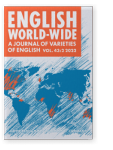Vol. 43:2 (2022) ► pp.220–248
Between first language influence, exonormative orientation and migration
Future time expressions in post-protectorate Ugandan English
Like other Englishes, Ugandan English is not a homogeneous variety. Being a second language to the vast majority of its multilingual speakers, it is, inevitably, influenced by their first languages. However, first language influence is just one factor that continues to shape Ugandan English. This paper reports on how influence from exonormative teaching models and the effects of migration, which constantly results in frequent and regular contact between second language speakers of various first languages, contribute to its architecture. It does so by focusing on and carefully investigating future time expressions in a corpus of authentic spoken interactions across Ugandans, the face-to-face conversations of the Uganda component of the International Corpus of English.
Article outline
- 1.Introduction
- 2.Englishes and interactions across Englishes in Uganda
- 2.1Ugandan Englishes
- 2.2Ethnic varieties in migration and loci of Interactions across Englishes
- 2.3Exonormative orientation and potential exogeneous influence
- 3.Future time and its expression
- 3.1Future time expressions in L1 English
- 3.2Future time expressions in L2 Englishes
- 3.3Concepts of futurity and expressions of future time reference in Uganda and Ugandan English
- 4.Data and methodology
- 4.1Data collection and participants
- 4.2Data analysis
- 5.Findings
- 5.1Grammatical influence factors and exonormative orientation
- 5.1.1Grammatical number of sentence subject
- 5.2Future time expressions by occupational status
- 5.3First language influence
- 5.4Future time expressions by location and potential exogenous influence
- 5.5Nilotic speakers in migration
- 5.1Grammatical influence factors and exonormative orientation
- 6.Discussion and concluding remarks
- Acknowledgements
- Notes
-
References
